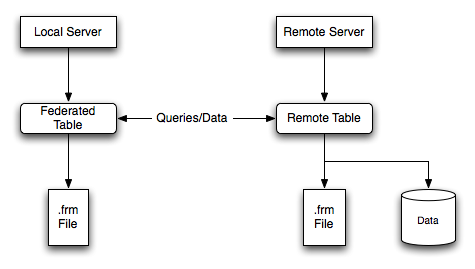- 13.11 The FEDERATED Storage Engine
- 13.11.1 FEDERATED Storage Engine Overview
- 13.11.2 How to Create FEDERATED Tables
- 13.11.3 FEDERATED Storage Engine Notes and Tips
- 13.11.4 FEDERATED Storage Engine Resources
When you create a table using one of the standard storage engines
(such as MyISAM, CSV or
InnoDB), the table consists of the table
definition and the associated data. When you create a
FEDERATED table, the table definition is the
same, but the physical storage of the data is handled on a remote
server.
A FEDERATED table consists of two elements:
A remote server with a database table, which in turn consists of the table definition (stored in the
.frmfile) and the associated table. The table type of the remote table may be any type supported by the remotemysqldserver, includingMyISAMorInnoDB.A local server with a database table, where the table definition matches that of the corresponding table on the remote server. The table definition is stored within the
.frmfile. However, there is no data file on the local server. Instead, the table definition includes a connection string that points to the remote table.
When executing queries and statements on a
FEDERATED table on the local server, the
operations that would normally insert, update or delete
information from a local data file are instead sent to the remote
server for execution, where they update the data file on the
remote server or return matching rows from the remote server.
The basic structure of a FEDERATED table setup
is shown in Figure 13.2, “FEDERATED Table Structure”.
When a client issues an SQL statement that refers to a
FEDERATED table, the flow of information
between the local server (where the SQL statement is executed) and
the remote server (where the data is physically stored) is as
follows:
The storage engine looks through each column that the
FEDERATEDtable has and constructs an appropriate SQL statement that refers to the remote table.The statement is sent to the remote server using the MySQL client API.
The remote server processes the statement and the local server retrieves any result that the statement produces (an affected-rows count or a result set).
If the statement produces a result set, each column is converted to internal storage engine format that the
FEDERATEDengine expects and can use to display the result to the client that issued the original statement.
The local server communicates with the remote server using MySQL
client C API functions. It invokes
mysql_real_query() to send the
statement. To read a result set, it uses
mysql_store_result() and fetches
rows one at a time using
mysql_fetch_row().


User Comments
Add your own comment.